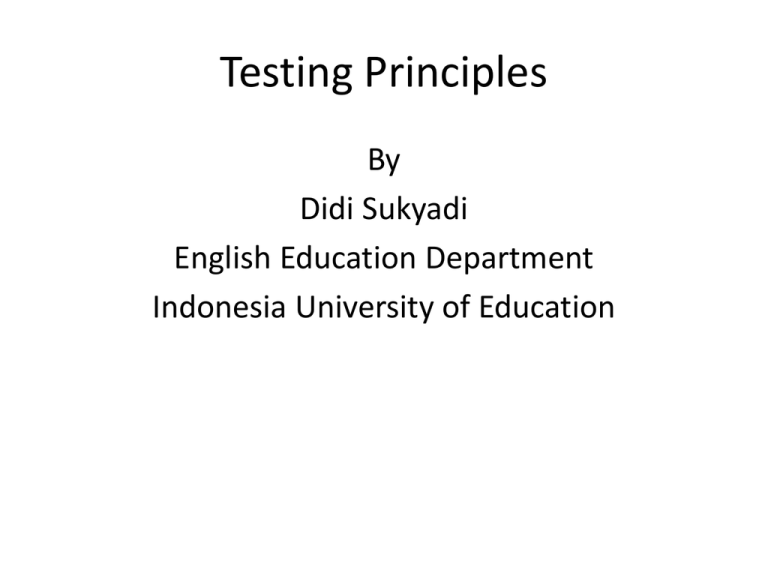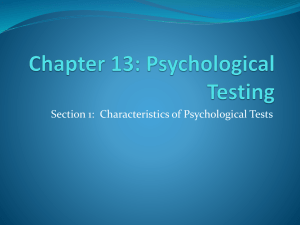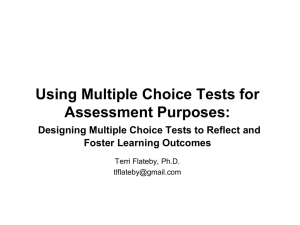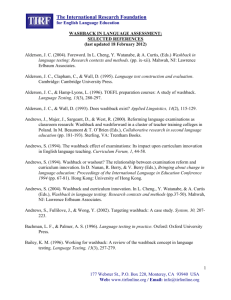Principles of language testing
advertisement

Testing Principles By Didi Sukyadi English Education Department Indonesia University of Education Practicality • • • • • • • • Is not excessively expensive Stays within appropriate time constraints Is relatively easy to administer Has a scoring/evaluation procedure that is specific and time efficient items can be replicated in terms of resources needed e.g. time, materials, people can be administered can be graded results can be interpreted Reliability • A reliable test is consistent and dependable. • Related to accuracy, dependability and consistency e.g. 20°C here today, 20°C in North Italy – are they the same? According to Henning [1987], reliability is • a measure of accuracy, consistency, dependability, or fairness of scores resulting from the administration of a particular examination e.g. 75% on a test today, 83% tomorrow – problem with reliability. Reliability • Student Related reliability: the deviation of an observed score from one’s true score because of temporary ilness, fatigue, anxiety, bad day, etc. • Rater reliability: two or more scores yield an inconsistent scores of the same test because of lack attention on scoring criteria, inexperience, inattention, or preconceived bias. • Administration reliability: unreliable results because of testing environment such as noise, poor quality of cassettee tape, etc. • Test reliability: measurement errors because the test is too long. To Make Test More Reliable • Take enough sample of behaviour • Exclude items which do not discriminate well between weaker and stronger students • Do not allow candidate too much freedom. • Provide clear and explicit instructions • Make sure that the tests were perfectly laid out and legible • Make candidates familiar with format and testing techniques To Make Test More Reliable • Provide uniform and undistracted conditions of administration • Use items that pemit objective scoring • Provide a detailed scoring key • Train scorers • Identify candidate by number, not by name • Employ multiple, independent scoring Measuring Reliability • Test retest reliability: administer whatever the test involved two times. • Equivalent –forms reliability/parallel-forms reliability: administering two different bu equal tests to a single group of students (e.g. Form A and B) • Internal consistency reliability: estimate the consistency of a test using only information internal to a test, available in one administration of a single test. This procedure is called Split-half method. Validity • Criterion related validity: the degree to which results on the test agree with those provided by some independent and highly dependable assessment of the candidates’ ability. • Construct validity: any theory, hypothesis, or model that attempts to explain observed phenomena in our universe and perception; Proficiency and communicative competence are linguistic constructs; self-esteem and motivation are psychological constructs. Reliability Coefficient • Validity coefficient to compare the reliability of different tests. • Lado: vocabulary, structure, reading (0,9-0,99), auditory comprehension (0,80-0,89), oral production (0,70-0,79) • Standard error: how far an individual test taker’s actual score is likely to diverge from their true score • Classical analysis: gives us a single estimatefor all test takers • Item Response theory: gives estimate for each individual, basing this estimate on that individual’s performance Validity • The extent to which the inferences made from assessment results are appropriate, meaningful and useful in terms of the purpose of the assessment. • Content validity: requires the test taker to perform the behaviour that is being measured. • Content validity: Its content constitutes a representative sample of the language skills, structures, etc. With which it is meant to be measured Validity • Consequential validity: accuracy in measuring intended criteria, its impacts on the preparation of test takers, its effects on the learner, and social consequences of test interpretation and use. • Face validity: the degree to which the test looks right and appears to the knowledge and ability it claims to measure based on the subjective judgement of examinees who take it and the administrative personnel who decide on its use and other psychometrical observers. Validity Response validity [internal] • the extent to which test takers respond in the way expected by the test developers Concurrent validity [external] • the extent to which test takers' scores on one test relate to those on another externally recognised test or measure Predictive validity [external] • the extent to which scores on test Y predict test takers' ability to do X e.g. IELTS + success in academic studies at university Validity • 'Validity is not a characteristic of a test, but a feature of the inferences made on the basis of test scores and the uses to which a test is put.' • To make test more valid: 1) Write explicit test specification 2) Use direct testing 3) Scoring of responses related directly to what is being tested. 4) Make the test reliable. Washback • The quality of the relationship between a test and associated teaching. • We have positive effect and negative effect. • Test is valid when it has a good washback • Students have ready access to discuss the feedback and evaluation you have given. Washback • The effect of testing on teaching and learning • The effect of test on instruction in terms of how students prepare for the test • Formative test: provides washback in the form of information to the learner on progress toward goals, while Summative test is always the beginning of further pursuits, more learning, more goals • To improve washback: use direct testing, use criterion reference-testing, base achievement tests on objectives, and make sure that the tests are understood by students and teachers. Evaluation of Classroom Tests • Are the test procedures practical? • Is the test reliable? • Does the procedure demonstrate content validity? • Is the procedure face valid and biased for best? • Are the test tasks as authentic as possible? • Does the test give beneficial washback? NRT and CRT • Is designed to measure the global language abilities such as overall English Proficiency, academic listening ability, reading comprehension, and so on. • Each student’s score on such a test is interpreted relative to the scores of all other students who took the test with reference to normal distribution • Criterion reference test is usually produced to measure well-defined and failrly specific instructional objectives • The interpretation of CRT is considered as absolute in a sense that each student’s score is meaningful without reference to the other students’ scores NRT and CRT Characteristics NRT CRT Types of interpretation Relative Absolute Type of measurement To measure general language abilities To measure specific objective-based language points Purpose of testing Spread students out a long a continuum of general abilities of proficiencies Assess the amount of material known or learned by each student Distribution of scores Normal distributiom Varies; often non normal. Test structure A few relatively long subtest with a variety of item content A series of short-well defined subtests with similar item contents Knowledge of questions Students have little or no idea of what content to expect in test items Student know exactly what content to expect in test items Test and Decision Purposes TYPES OF DECISION NORM-REFERENCED CRITERION-REFERENCED Test Qualities Proficiency Placement Achievement Diagnostic Detail of information Very general general specific Very specific Focus General skills prerequisite to entry From all levels & skills of program Terminal objectives of course Terminal and enabling objective Purpose of Decision To compare individual and individual To find each student’s appropriate level To determine the degree of learning for advancement or graduation To inform students and teachers of weaker objectives Relationship to Program Comparisons with other institutions Comparison within program Directly related to objectives Related to objectives need more worls Interpretation When administered Before entry and at exit Beginning of program End of courses Beginning and/or middle of courses Characteristics of communicative tests • Communicative test setting requirements: 1) Meaningful communication 2) Authentic situation 3) Unpredictable language input 4) Creative language output 5) All language skills • Bases for ratings 1) Success in getting meaning across 2) Use focus rather than usage 3) New components to be rated Components of Communicative competence • Grammatical competence (phonology, orthography, vocabulary, word formation, sentence formation) • Sociolinguistic competence (social meanings, grammatical forms in different sociolinguistic contexts) • Discourse competence (cohesion in different genres, cohesion in different genres) • Strategic competence (grammatical difficulties, sociolinguistic difficulties, discourse difficulties, performance factors) Discrete-point/Integrative Issue • Discrete point: measures the small bits and pieces of a language as in a multiple choice test made up of questions constructed to measure students’ knowledge of different structure • Integrative test: measures several skills at one time such as dictation Practical Issues • Fairness issue: a test treats every student the same. • The cost issue • Ease of test construction • Ease of test administration • Ease of test scoring • Interactions of theoretical issues General Guidelines for Item Formats • • • • • • • • • • correctly matched to the purpose and content of the item only one correct answer? written at the students’ level of proficiency Avoiding ambiguous terms and statements Avoiding negarives and double negatives Avoid giving clues that could be used in answering other items All parts of the item on the same page Only relevant information presented Avoiding bias of race, gender and nationality Let another person look over the item More than one correct answer • The apple is located on or around • A) a table C) the table • B) an table D) table - Two correct answers (A and C), wordy (somewhere around), repeat the word table inefficiently Multiple Choice • Do you see the chair and table? The apple is on _____ table. a) A c) the b) An d) (no article) Option d (no article) will be easily detected as a wrong option so it is not a good distracter. True-False • According to the passage, antidisestablismentarianism diverges fundamentally from the conventional proceedings and traditions of the Church of England * Containing too difficult vocabulary. Ambiguous Word • Why are statistical studies inaccessible to language teachers in Brazil according to the reading passage? • Accessible: language teachers get very little training in mathematics and/or such teachers are averse to numbers • Accessible: the libraries may be far away. Double negatives • One theory that is not unassociated with Noam Chomsky is: • A. Transformational generative grammar • B. Case grammar • C. Non-universal phonology • D. Acoustic phonology - Use one negative only - Emphasize it by underline, upper case, or boldface. For example: not, NEVER, inconsistent Receptive response items • True-False 1) the statement worded carefully enough so it can be judged without ambiguity 2) absoluteness clues are avoided • Multiple Choice 1) Unintentional clues are avoided 2) The distracters are plausible 3) Needless redundancy in the options is avoided 4) Ordering of the option is carefully considered 5) The correct answers are randomly assigned • Matching 1) More options than premises 2) Options shorter than premises to reduce reading 3) Option and premise lists r elated to one central theme True-False • Items should be worded carefully enough so it can be judged without ambiguity • Avoid absoluteness • This book is always crystal clear in all its explanation: T F - allow the students to answer correctly without knowing the correct response. - Absolute clues: all, always, absolutely, never, rarely, most often Multiple Choice • Avoid unintentional clues • The fruit that Adam ate in the Bible was an ____ A. Pear C. Apple B. Banana D. Papaya Unintentional clues: grammatical, phonological, morphological, etc. Multiple Choice Are all distracters plausible? Adam ate _______ A. An apple C. an apricot B. A banana D. a tire Multiple Choice • Avoid needless redundancy • The boy on his way to the store, walking down the street, when he stepped on a piece of cold wet ice and A. fell flat on his face B. fall flat on his face C. felled flat on his face D. falled flat on his face Multiple Choice • More effective: The boy stepped on a piece of ice and ______ flat on his face. A. fell B. fall C. felled D. falled Multiple Choice • Correct answers should be randomly assigned • Distracters like “none of the above”, “A and B only”, “all of the above should be avoided Matching • Present the students with two columns of information; the students then must find and identify matches between the two sets of information. • The information on the left-hand column is called matching-item premise • On the right hand column is called option Matching • More options should be supplied than premises so the students can narrow down the choices as they progress through the test simply by keeping track of the options they have used. • Options should be shorter than premises because most students will read a premise then search through the options • The options and premises should relate to one central theme that is obvious to students Fill in Items • The required response should be concise • Bad item: • John walked down the street ________ (slowly, quickly, angrily, carefully, etc.) • Good item: • John stepped onto the ice and immediately ____ down hard (fell) Fill in Items • There should be a sufficient context to convey the intent of the question to the students. • The blanks should be standard in length • The main body of the question should precede the blank • Develop a list of acceptable responses Short Response • Items that the students can answer in a few phrases or sentences. • The item should be formatted that only one relatively concices answer is possible. • The item is framed as a clear and direct item • E.g. According to the reading passage, what are the three steps in doing research? Task Items • Task item is any of a group of fairly-open ended item types that require students to perform a task in the language that is being tested. • The task should be clearly defined • The task should be sufficiently narrow for the time available. • A scoring procedure should be worked out in advance in regard to the approach that will be used. • A scoring procedure should be worked out in advance in regard to the categories of language that will be rated. • The scoring procedure should be clearly defined in terms of what each scores within each category means. • The scoring should be anonymous Analytic Score for Rating Composition Tasks 20-18 Excellent to Good Organization (introduction, body, conclusion) Logical development of ideas Grammar Punctuation, Spelling, mechanics Style and 17-15 Good to Adequate 14-12 115-1 Adequate to Unacceptable NotFair college level work Holistic Version of the Scale for Rating Composition Tasks • • • • • Content Organization Language Use Vocabulary Mechanics Personal Response Items • The response allows the students to communicate in ways and about things that are interesting to them personally • Personal Responses include: self assessment, conferences, porfolio Self-Assessment • Decide on a scoring type • Decide what aspect of students’ language performance they will be assessing • Develop a written rating for the learners • The rating scale should decide concrete language and behaviours in simple terms • Plan the logistics of how the students will assess themselves • The students should the self-scoring procedures • Have another student/teacher do the same scoring Conferences • Introduce and explain conferences to the students • Give the students the sense that they are in control of the conference • Focus the discussion on the students’ views concerning the learning process • Work with the students concerning self-image issue • Elicit performances on specific skills that need to be reviewed. • The conferences should be scheduled regularly Portfolios • • • • Explain the portfolios to the students Decide who will take responsibility for what Select and collect meaningful work. The students periodically reflect in writing on their portfolios • Have other students, teachers, outsiders periodically examined the portfolios.







